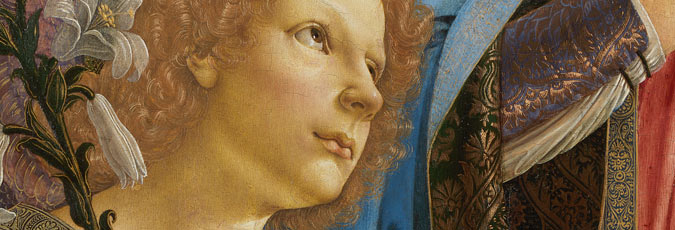New attribution
The Virgin and Child with Two Angels, (about 1475) has long enjoyed a prominent place in the Sainsbury Wing. However, its label, giving it merely to the ‘Workshop of Verrocchio’, has caused it to be significantly undervalued.
Conservation work
After painstaking work by Jill Dunkerton of the National Gallery’s Conservation Department, the picture is now revealed in all its glory. Dunkerton has removed the disfiguring residues of three previous campaigns of restoration going right back to the 18th century. As she says:
‘The oldest restoration was very hard to remove and I had to work on tiny areas using a microscope for weeks on end. It was also quite a challenge to retouch the damaged areas of a painting with such an exquisite technique, especially the Virgin’s head and the beautiful angel on the left.’
The quality and technique of the Virgin and the left-hand angel, which Jill Dunkerton took such efforts on, entirely match that of Verrocchio’s most beautiful drawings. The painting of the flesh has the wonderful inner glow of his sculpture in marble from the mid-1470s.
Verrocchio's assistant
It has, however, also become clear that the picture was not painted by Verrocchio alone, as the picture’s curator Luke Syson explains:
‘We need only compare the extraordinary three-dimensionality and anatomical precision of the raised hand of the angel on the left – exactly of the quality one would expect from this marvellous sculptor and draughtsman – with the slightly boneless, shinier hand of the angel on the right to see that Verrocchio had help’.
The assistant seems to have been responsible for the execution and perhaps the design of the right angel, the Christ Child and the curtains. Dunkerton and Syson believe that Verrocchio’s assistant was his last major pupil, Lorenzo di Credi.
This is not the only work at the Gallery which can be attributed to Verrocchio. A further conservation campaign has revealed another painting, which appears to be entirely by Verrocchio’s hand.


